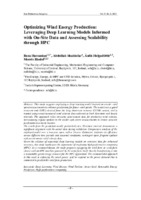Optimizing Wind Energy Production: Leveraging Deep Learning Models Informed with On-Site Data and Assessing Scalability through HPC

Megtekintés/
Metaadat
Teljes megjelenítés
Link a dokumentumra való hivatkozáshoz:
Gyűjtemény
Absztrakt
This study suggests employing a deep learning model trained on on-site wind
speed measurements to enhance predictions for future wind speeds. The model uses a gated
recurrent unit (GRU) derived from the long short-term memory (LSTM) variant, and is
trained using actual measured wind velocity data collected at both 10-minute and hourly
intervals. The approach relies on using same-season data for predicting wind velocity,
necessitating regular updates to the model with recent measurements to ensure accurate
predictions in a timely manner.
The results from the prediction model, particularly at a 10-minute interval, demonstrate a
significant alignment with the actual data during validation. Comparative analysis of the
employed model over a two-year span, with a 24-year distinction, indicates its efficiency
across different time periods and seasonal conditions, contingent upon frequent updates
with recent on-site wind velocity data.
Given the reliance of sequential deep learning models on extensive data for enhanced
accuracy, this study emphasizes the importance of employing high-performance computing
(HPC). As a recommendation, the study proposes equipping the wind farm or wind farm
cluster with an HPC machine powered by the wind farm itself, thereby transforming it into
a sustainable green energy resource for the HPC application. The recommended approach
in this work is enforcing the smart power grid to respond to the power demand that is
connected to predictable wind farm production.
- Cím és alcím
- Optimizing Wind Energy Production: Leveraging Deep Learning Models Informed with On-Site Data and Assessing Scalability through HPC
- Szerző
- Hassanian, Reza
- Shahinfar, Abdollah
- Helgadóttir, Ásdís
- Riedel, Morris
- Megjelenés ideje
- 2024
- Hozzáférés szintje
- Open access
- ISSN, e-ISSN
- 1785-8860
- Nyelv
- en
- Terjedelem
- 12 p.
- Tárgyszó
- deep learning, wind energy, wind turbine, smart grid, renewable energy prediction, high-performance computing
- Változat
- Kiadói változat
- Egyéb azonosítók
- DOI: 10.12700/APH.21.9.2024.9.4
- A cikket/könyvrészletet tartalmazó dokumentum címe
- Acta Polytechnica Hungarica
- A forrás folyóirat éve
- 2024
- A forrás folyóirat évfolyama
- 21. évf.
- A forrás folyóirat száma
- 9. sz.
- Műfaj
- Tudományos cikk
- Tudományterület
- Műszaki tudományok - multidiszciplináris műszaki tudományok
- Egyetem
- Óbudai Egyetem
